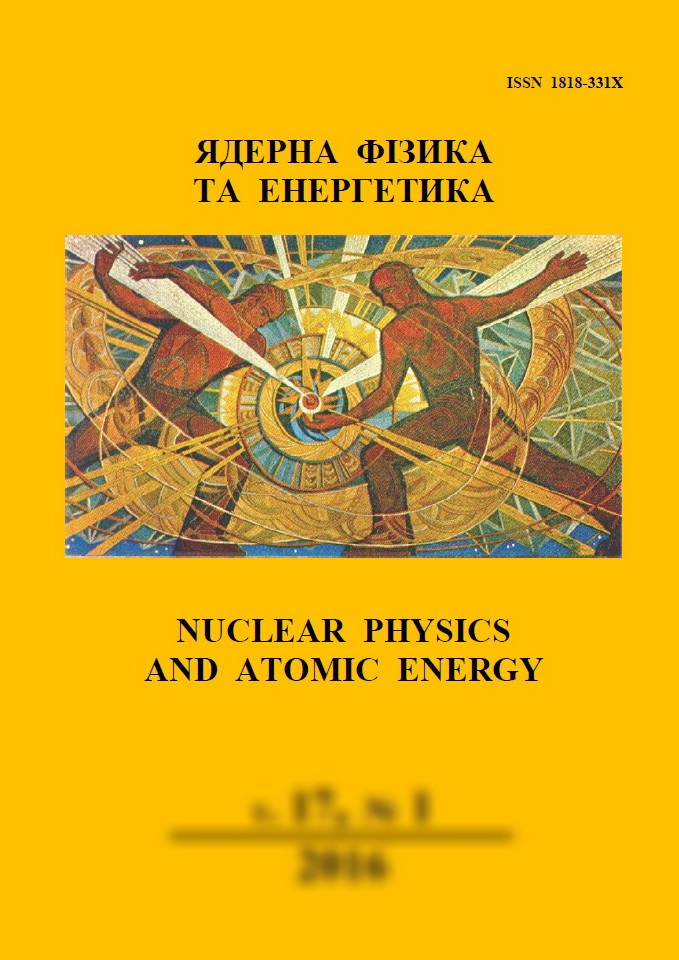 |
Ядерна фізика та енергетика
Nuclear Physics and Atomic Energy
ISSN:
1818-331X (Print), 2074-0565 (Online)
Publisher:
Institute for Nuclear Research of the National Academy of Sciences of Ukraine
Languages:
Ukrainian, English, Russian
Periodicity:
4 times per year
Open access peer reviewed journal
|
Nucl. Phys. At. Energy 2018, volume 19, issue 4, pages 392-399.
Section: Engineering and methods of experiment.
Received: 03.08.2018; Accepted: 11.10.2018; Published online: 14.02.2019.
 Full text (ru)
Full text (ru)
https://doi.org/10.15407/jnpae2018.04.392
Synthesis of birnessite-type manganese oxide for removal of strontium ions from contaminated water
Yu. V. Bondar*, S. V. Kuzenko
State Institution "Institute of Environmental Geochemistry of the National Academy of Sciences of Ukraine",
Kyiv, Ukraine
*Corresponding author. E-mail address:
juliavad@yahoo.com
Abstract:
Manganese oxide is perspective material for selective removal of strontium ions from multicomponent solutions. Birnessite-type manganese oxide with the hexagonal disordered structure has been synthesized in the form of round microparticles. The synthesized samples have been tested for the removal of strontium ions from mono- and multicomponent solutions. It was found that birnessite can effectively remove strontium ions from monocomponent solutions. The presence of alkaline metal ions (up to ~ 0.3 M) in the multicomponent solutions has no significant effect on adsorption; however, calcium ions (Ca/Sr ~ 30/1) lead to the considerable decrease in adsorption. The rather high adsorption parameters received in the experimental work allow to consider the synthesized birnessite as a sorbent with high selectivity towards strontium ions.
Keywords:
manganese dioxide, birnessite, adsorption, selectivity, 90Sr.
References:
1. G.V. Myasoyedova, V.A. Nikashina. Sorption materials for the extraction of radionuclides from aquatic environments. Rossiyskiy Khimicheskiy Zhurnal 50(5) (2006) 55. (Rus)
http://www.chem.msu.su/rus/jvho/2006-5/55.pdf
2. V.A. Avramenko et al. Modern technologies in the practice of handling with "problem" LRW in the Far East region as a perspective for "Fukushima-1". Sovremennyye Naukoyemkiye Tekhnologii 10 (2016) 9. (Rus)
https://www.top-technologies.ru/pdf/2016/10-1/36270.pdf
3. V.V. Milyutin et al. Sorption technologies in modern applied radiochemistry. Sorbtsionnyye i Khromato-Graficheskiye Protsessy 16(3) (2016) 313. (Rus)
http://www.sorpchrom.vsu.ru/articles/20160305.pdf
4. G.V. Leont'yeva. Structural modification of manganese oxides (III, IV) in the synthesis of sorbents selective for strontium. Zhurnal Prikladnoy Khimii 70(10) (1997) 1615. (Rus)
5. S.A. Kirillov, T.V. Lisnycha, O.I. Pendeluk. Appraisal of mixed amorphous manganese oxide / titanium oxide sorbents for the removal of strontium-90 from solutions, with special reference to Savannah river site and Chernobyl radioactive waste simulants. Adsorpt. Sci. Technol. 24(10) (2006) 895.
https://doi.org/10.1260/026361707781421979
6. T.P. Valsala et al. Separation of strontium from low-level radioactive waste solutions using hydrous manganese dioxide composite materials. J. Nucl. Mater. 404 (2010) 138.
https://doi.org/10.1016/j.jnucmat.2010.07.017
7. S. Oh, W.S. Shin, S.J. Choi. Hydrous manganese oxide-polyacrylonitrile (HMO-PAN) composite for the treatment of radioactive laundry wastewater. J. Radioanal. Nucl. Chem. 303 (2015) 495.
https://doi.org/10.1007/s10967-014-3583-2
8. V.V. Milyutin. Physico-chemical methods for the extraction of radionuclides from liquid radioactive waste from low and medium levels of activity. Thesis Abstract of Doctor of Chemical Sciences (Moskva, 2008) 49 p. (Rus)
9. A. Dyer et al. Sorption behavior of radionuclides on crystalline synthetic tunnel manganese oxides. Chem. Mater. 12(12) (2000) 3798.
https://doi.org/10.1021/cm001142v
10. J.W. Murray. The interaction of metal ions at the manganese dioxide-solution interface. Geochim. Cosmochim. Acta 39(4) (1975) 505.
https://doi.org/10.1016/0016-7037(75)90103-9
11. J.E. Post. Manganese oxide minerals: Crystal structures and economic and environmental significance. Proc. Nat. Acad. Sci. USA 96 (1999) 3447.
https://doi.org/10.1073/pnas.96.7.3447
12. V.A. Kuznetsov, V.A. Generalova, V.P. Kol'nenkov. Forms of strontium-90 and cesium-137 location on ferruginous hypergene mineral. Doklady Akademii Nauk Belarusi 37(2) (1993) 201. (Rus)
13. V.A. Kuznetsov, V.A. Generalova. Radionuclides and colloidal manganese compounds in landscapes. Lithosphere 1 (1994) 146. (Rus)
14. Yu.A. Voroshilov et al. Studying the ISM-S sorbent and testing the sorption technology based on it for water purification from 90Sr of the reservoir-storage of IA "Mayak". Radiokhimiya 45(1) (2003) 62. (Rus)
https://doi.org/10.1023/A:1022325703593
15. J.W. Murray. The surface chemistry of hydrous manganese dioxide. J. Colloid Interface Sci. 46(3) (1974) 357. https://doi.org/10.1016/0021-9797(74)90045-9
16. С.K. Remucal, M. Ginder-Vogel. A critical review of the reactivity of manganese oxides with organic contaminants. Environ. Sci. Process. Impacts 16(6) (2014) 1247.
https://doi.org/10.1039/C3EM00703K
17. H. Boumaiza et al. Conditions for the formation of pure birnessite during the oxidation of Mn(II) cations in aqueous alkaline medium. J. Solid State Chem. 248 (2017) 18.
https://doi.org/10.1016/j.jssc.2017.01.014
18. V.A. Drits, B. Lanson, A.C. Gaillot. Birnessite polytype systematics and identification by powder X-ray diffraction. Am. Mineral. 92(5-6) (2007) 771.
https://doi.org/10.2138/am.2007.2207
19. M. Villalobos et al. Characterization of the manganese oxide produced by Pseudomonas putida strain MnB1. Geochim. Cosmochim. Acta 67(14) (2003) 2649.
https://doi.org/10.1016/S0016-7037(03)00217-5
